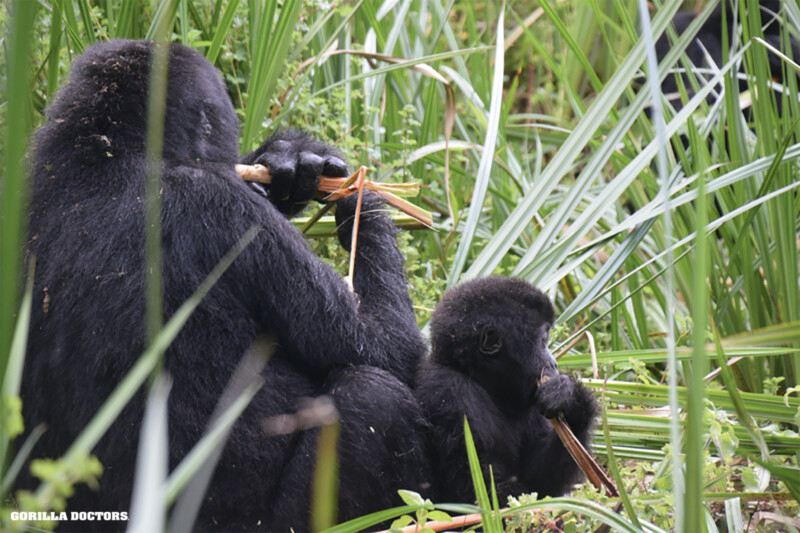Dr. Lina’s Special Forest Encounter
By Gorilla Doctors Staff on Wednesday, May 8th, 2024 in Blog.By Dr. Lina Nturubika, field veterinarian, DR Congo
A couple of weeks ago I was in the forest on my way to conduct a routine health check of Bonane group. This is a family of ten critically endangered Grauer’s gorillas in Kahuzi-Biega National Park. I love visiting this group because it has four infants!

Youssoupha, an infant Grauer’s gorilla in Bonane group, Kahuzi-Biega National Park, DR Congo. April 2024. © Gorilla Doctors
I was accompanied by one park guard and three trackers. It was a lovely sunny day, and we found the group early, a little before 8:00AM. The gorillas seemed to still be in the process of waking up! They had not wandered far from their night nests and were slowly feeding and moving in the direction of Cirumbu Swamp.

Descryver, a juvenile Grauer’s gorilla in Bonane group on the move! Kahuzi-Biega National Park, DR Congo. April 2024. © Gorilla Doctors
Silverback Bonane spent some time feeding up in the trees, so we moved along with the group, giving me the opportunity to visually observe each individual in the group for any signs of illness or injury.

Bonane, lead silverback of Bonane group, climbs down from feeding up in the trees. Kahuzi-Biega National Park, DR Congo. April 2024. © Gorilla Doctors
Once they settled in the swamp area to feed, the vegetation was not quite as dense, and I was able to complete the health check. All the gorillas were in good visual health – my favorite report to write-up.

Mukono and her infant, Youssoupha, feeding in Cirumbu Swamp. KAhuzi-Biega National Park, DR Congo. April 2024. © Gorilla Doctors
Unexpectedly, we encountered another group of primates. As it so happens, a delegation of human ‘primates’ arrived to visit with Bonane group right as we were leaving. Among the visitors were some very special guests:
Lucy Tamlyn, US Ambassador to DRC
Yves Milan Ngangay, Executive Director of ICCN, the Congolese Wildlife Authority
Dr. Jean-Paul Kibambe Lubamba, National Director for Wildlife Conservation Society (WCS)
Cirimwami Lambert, Head Guide for Kahuzi-Biega National Park
The group was visiting the park for the official launch of the Environmental Partnerships Program – “Protecting our rights and our environment”, translated into Swahili as “Tulinde haki na mazingira yetu”– USAID’s innovative program in the Democratic Republic of Congo.

Guest delegation visiting with Bonane group and Dr. Lina. Kahuzi-Biega National Park, DR Congo. April 2024. © Gorilla Doctors
Following their visit with Bonane group the delegation stopped to rest at ‘Bwamba Deschryver’ – a spot in the forest where Adrien Deschryver, a Belgian photographer and conservationist, was known to rest after visiting the gorillas. Deschryver worked with the Congolese government to help establish Kahuzi-Biega National Park in 1970.
Ambassador Tamlyn was very curious about Gorilla Doctors, and we had a fruitful exchange. I thought you would appreciate hearing my answers to her great questions:
Q1. Are you only here in Congo?
No! Gorilla Doctors provides life-saving veterinary medicine in all the countries where eastern gorillas range – here in eastern DR Congo, Rwanda, and Uganda.
Q2. Do you go into the forest every day to follow them?
Almost daily! Our hospital is the forest, and we do all our health monitoring and clinical interventions in their home environment, so we are in the forest almost everyday rain or shine. We do sometimes stay at our field stations to write-up reports and attend meetings, but as field veterinarians of course we prefer to be out in the forest with our patients!
Q3. How many gorillas are there?
We monitor the health of both mountain and Grauer’s gorillas, the two eastern gorilla subspecies. We have close to 800 gorilla ‘patients’. We can only actively care for habituated gorillas – gorillas accustomed to the presence of humans. Not all eastern gorillas are habituated. There are a total of just over 1,000 mountain gorillas in the wild, between the two populations (Virunga Massif and Bwindi-Sarambwe), and approximately 65% are habituated to humans. Grauer’s gorilla numbers have declined significantly over the last couple of decades, and most are not habituated to humans. The last survey conducted in 2021 estimates a population of just 6,800.
Q4. What do you do if a gorilla needs treatment?
When a gorilla is ill or injured, we bring all our supplies and equipment to the forest and treat them in their home environment while surrounded by their gorilla family. In most cases we can provide medication remotely via dart. If an illness or injury is life threatening, a snare for example, we can anesthetize the individual and provide more hands-on treatment.
Q5. Do the other members of the group let you treat them?
Yes, but it does require help from a brave group of trained park trackers. When we must anesthetize a gorilla, the intervention team will form a wide circle around us and using calming vocalizations and arm movements, keep the other gorillas in the group at a safe distance while we work. In one extraordinary case – this was before I started with Gorilla Doctors – there was a silverback in a group of mountain gorillas who acted as if he ‘knew’ that we were there to help. This silverback actually stood between Dr. Eddy and the other gorillas, keeping them from charging at Dr. Eddy while he worked!

Stamila, an adult female Grauer’s gorilla watching the humans while the humans watch her! April 2024. © Gorilla Doctors


 Donate
Donate